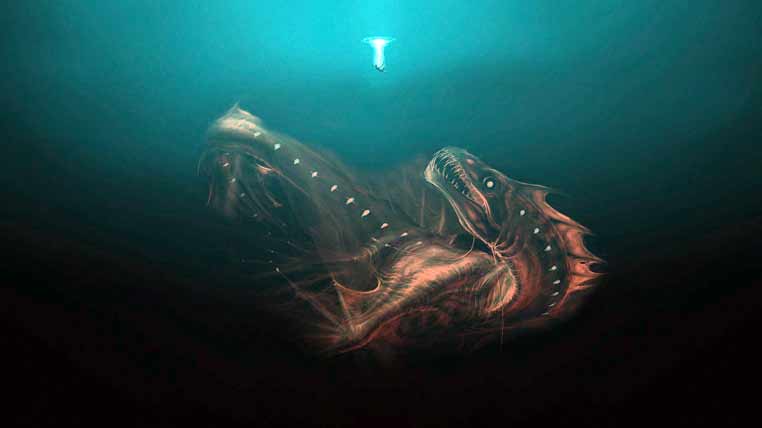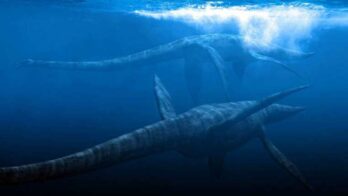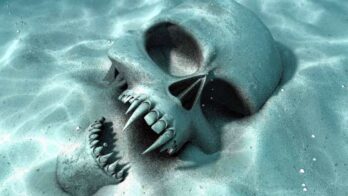Creatures like the Champ monster, which we will discuss in this article, have been reported in dozens of locations around the world.
Even though humankind has been sailing the seas and oceans of the Earth for centuries, their abyssal depths remain as mysterious as the infinite universe.
However, with the help of recent scientific advances, we have begun to explore these underwater worlds, attempting to learn as much as possible about the dark depths that cover our planet; it will probably take decades before we have a complete picture of everything that is hidden at the bottom of the seas and oceans.
The mysterious Lake Champlain monster
Although Nessie (or the Loch Ness monster) is the most famous of all water monsters, there are still reports of other gigantic creatures in freshwater lakes from various parts of the world.
One of these creatures is the “Champ monster.”
In Lake Champlain, located at the border of Vermont and New York, there is said to be a mysterious creature locals call the Champ monster.
According to some, this so-called Champ monster is the American version of the more famous Loch Ness monster: a large animal with a long neck that, in broad strokes, resembles a plesiosaur, an aquatic reptile thought to have disappeared 65 million years ago.
Lake Champlain is an impressive expanse of cold, deep water formed around 10,000 years ago from the melting of glaciers.
Basically, Champlain is the largest body of water, aside from the Great Lakes, housing about 80 species of fish, more than enough to feed an entire family of monsters, if they exist.
According to popular belief, the first person to see the Champ monster was a French explorer named Samuel de Champlain, after whom the lake was named.
The local legends talk about how Samuel de Champlain mentioned the creature he saw in a chronicle from 1609, which referred to the explorations undertaken on the valleys of the St. Lawrence River and its tributary rivers.
In this source, which is presumed to have been consulted by several researchers, the explorer mentioned a large fish that, according to his description, was identified as a pike, a freshwater predator whose existence in the lake is attested to this day.
The Champ monster: Strange reports from 1873
The first newspaper report about the Champ monster, the legendary creature said to be hiding in the waters of Lake Champlain, was in the Whitehall Times on July 9, 1873.
The article spoke of the incredible adventures of teams of railway workers who, while building a railway line near the lake, near Dresden, saw “the head of an enormous serpent emerging from the water and approaching from the opposite shore.”
At first, the workers were paralyzed with fear, then scattered in all directions.
Here is a short fragment from the article:
As he swam away with great speed, portions of his body, which appeared covered in glistening, silvery scales, shimmered in the sun like polished metal.
Water jets sometimes shot out of his nostrils, rising about 20 feet above his head. His head was round and flattened, with some sort of hood protruding from the lower part, like the rubber hats sailors often wear to keep rain from dripping down their necks.
He had small, piercing eyes, and two rows of teeth were visible in his mouth. As he moved away at a speed of about 10 miles per hour, portions of his body appeared on the surface of the water, and he also frequently lifted his tail, which resembled that of a fish.
His head measured about 20 inches in diameter. When he reached about a quarter of a mile out into the lake, he suddenly vanished into the water.
And this is how the legend of the Champ monster was born.
Shortly after this incident was reported in Dresden, local farmers began to complain that their cattle were disappearing.
The serpentine-like tracks and other marks found on the ground indicated that something had dragged the cattle into the lake. Some locals also claimed to have seen “terrifying eyes glowing in the darkness of the night in the caves on the water’s edge.”
A young farmer also told of seeing the serpent in the swamps at the lake’s edge, holding a turtle in its mouth. When he fired his gun, the creature disappeared into the water.
On July 31, 1883, the Plattsburgh Telegraph newspaper reported that Nathan Mooney, the sheriff of Clinton County, had “seen an enormous water serpent, 25 to 35 feet long.”
Starting in the summer of 1886, sightings of the Champ monster were reported almost daily in nearly all lake areas.
What does the monster look like?
In the twentieth century, confusion about the identity of the Champ monster grew.
Descriptions varied from witness to witness, with some claiming that the strange creature was not actually a water monster but lived hidden in the area’s caves.
However, the Champ monster, with its plesiosaur-like appearance, only became the classic monster in the 1970s.
In no recorded sightings at the time was there any mention of an animal with a long neck attached to a bulky body.
The few reports from the early period that referred to an animal with such characteristics were based only on the eyewitness accounts of a few individuals.
For example, the story recounted by an elderly woman after at least four decades after her encounter with the so-called sea monster.
The woman claimed that in the 1920s and 1930s, she and her brother saw a creature (possibly the Champ monster) suddenly emerge from the water’s surface with three humps like a camel and a head like a boa constrictor.
Many of the reports before 1970 are so ambiguous and lacking in relevant details that drawing a precise portrait of the Champ monster is almost impossible.
From the somewhat coherent descriptions, the animal looked like a giant snake. Some mentioned scales, which snakes do not have. Others referred to big fish, probably sturgeon, and witnesses likened the animal they saw to a whale on a few occasions.
The mystery deepens
One sighting of the Champ monster in the summer of 1970 was particularly interesting for two reasons.
Firstly, several witnesses were involved in this incident, independently of each other. Secondly, the event clarifies how some people’s imaginations can transform a serpent-like creature into a plesiosaur, similar to the one at Loch Ness.
On August 9, 1970, the Plattsburgh Valley News newspaper published two accounts from witnesses who claimed to have seen the Champ monster but had kept the incident secret for eight years.
One of the witnesses, Richard Spear, recounted that he and his 13-year-old daughter, Susanne, were on the ferry deck, halfway across the lake, heading towards Essex, New York.
At one point, according to Spear’s account, he spotted a strange creature about 90 yards from the shore:
The monster was olive-brown in color and had the size and shape of a barrel in its central section. When I first saw it, I discerned two bumps that rose above the water.
Meanwhile, another witness on board, Mrs. Happy Marsh, whose statement was published in the same issue of the newspaper, offered a completely different description:
It was a large creature resembling a serpent; it swam with its head above water like a snake. I can’t judge its length, but I say it measured between 18 and 20 feet. It was black and swam slowly.
Its head measured about three feet and was wrinkled like a raisin. It had a small crest along its spine. It had a snake-like body and was brown-black.
In 1979, some sonar experiments recorded evidence of a five-meter-long object moving underwater.
However, the data collected by the research team was not conclusive enough to convince skeptics of the monster’s existence.
Searching for Champ monster
More recent sightings of the Champ monster are as controversial as those from the previous century.
In 2002, on August 9, two witnesses saw a creature with a long neck emerging from the water about 20 yards away. The two suspected it might have been a small-sized monster, possibly a juvenile.
A couple of weeks after this incident, an adult monster was sighted in Bulwagga Bay. The creature was about 14 feet long and was swimming 15 yards from the shore.
In the summer of 2005, while two fishermen, Pete Bodette and Dick Affolter, were filming their new boat, they suddenly noticed a large, black object approaching from the depths.
Indeed, the footage shows a sizable, semi-submerged object moving in the background.
The recording of the two fishermen was studied by two former FBI forensic specialists specializing in image analysis, who confirmed that the footage had not been manipulated in any way.
Champ monster may be a product of imagination influenced by erroneous perceptions or hoaxes.
In that case, the Champ monster can easily signify the archetype of mysterious animals, some already known but nonexistent in that place, others conventional even if they are common, plus some genuinely unknown creatures.
On the other hand, being connected to the ocean, lake Champlain makes it possible for such creatures to enter or exit the lake.
Until tangible evidence is obtained, everything said about the fabulous monster, the Champ monster of lake Champlain, will be purely speculative.
At Ancient Theory we only use trusted sources to document our articles. Such relevant sources include authentic documents, newspaper and magazine articles, established authors, or reputable websites.
- Champ: Real Or Imagined. A Vermont Legend. westhillbb.com.
- Samuel de Champlain - Voyages of Samuel de Champlain. [Source]
- Plattsburgh Republican. July 24, 1819. [Source]
- Beth Demmon - Searching for Champ: Lake Champlain’s mythical monster is either a gentle giant or a silly hoax. Articol publicat la data de 29 august, 2019. roadtrippers.com.






